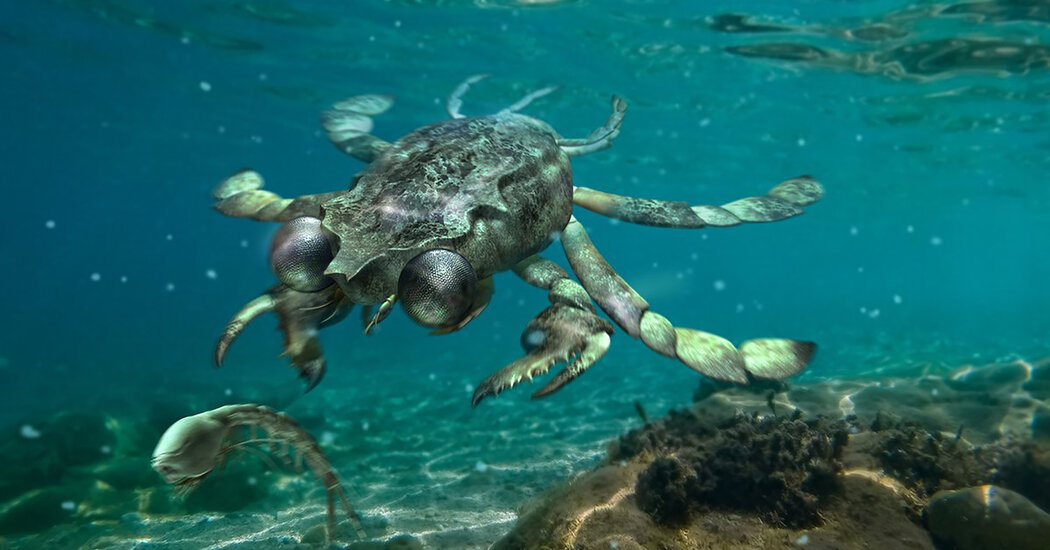A study of fossils from Colombia suggests that a prehistoric shellfish hunted prey with remarkably sharp vision.
Modern, adult crabs are not renowned for their swimming ability or their vision. They scuttle across the floors of silent seas, hardly reliant on small eyes as they scavenge or graze.
But 95 million years ago, an unusual crab flitted with unusual grace around the tropical waters of what is now Colombia. The quarter-size species, Callichimaera perplexa, looked a bit like a spider, with flat, oarlike legs and a keeled body. And it had a large set of eyes, too.
In a study published last month in the journal iScience, a group of paleontologists have shown that those eyes gave Callichimaera remarkably sharp vision and a likely lifestyle as a free-swimming predator.
The species was initially discovered in 2005 by Javier Luque, a paleontologist from Colombia and now a research fellow at Harvard University. Then an undergraduate, he was exploring the fossil-rich rocks of Colombia’s Boyacá department, as the country’s provinces are known, when he stumbled upon an outcrop full of finely detailed fossil arthropods.
Dr. Luque and his colleagues eventually collected over a hundred specimens, many of them extremely well-preserved. “It’s a huge sample size,” Dr. Luque said. “Seldom do you have 100 specimens.”
Seven of the specimens preserved detailed eyes. But these presented a puzzle, Dr. Luque said: Living crabs usually have tiny compound eyes, which are at the end of a stalk and covered by a protective orbit. Callichimaera’s compound eyes were large, with no stalk or orbits.
Crabs go through multiple stages of growth, beginning life as tiny, rather shrimplike creatures before settling into their final armored forms. In the last larval stage, the megalopa, young crabs are free-swimming predators that have relatively big eyes. When Dr. Luque and his colleagues formally described the fossil in 2019, they therefore thought it might represent a crab in its last larval stage, albeit an unusually large one.
“If you’ve got these huge eyes, you must be using them for something, especially since no other crab has this,” said Kelsey Jenkins, a paleontologist at Yale and a co-author on the paper. “Javier wanted a more in-depth look at this animal, because its anatomy is so weird.”
To figure out how Callichimaera used its eyes, Ms. Jenkins and Dr. Luque used the abundance of available Callichimaera specimens to put together a growth sequence. They compared this with 14 living species from across the crab family tree. They were surprised to find that — unlike other crab species — Callichimaera retained its large eyes into adulthood.
In fact, their calculations showed that Callichimaera’s compound eyes grew faster than those of the modern crabs the team sampled. At their final size, their eyes took up around 16 percent of their body, the equivalent of a person walking around with eyes the size of soccer balls.
Animals with compound eyes have an essentially pixelated view of the world, Ms. Jenkins said, with each facet of the eye delivering a separate pixel. The higher the pixel count, the sharper the vision. The team’s analysis of Callichimaera’s eyes suggests that it had unusually sharp vision for a crab — closer to efficient, cleareyed predators like dragonflies and mantis shrimps.
“Whatever this animal was doing, it must have used such big eyes actively,” Dr. Luque said. ‘They’re a huge drag in the water, and they’re vulnerable. So whatever drawbacks that are there for such big eyes, they must have been nothing compared to the advantages.”
When combined with the paddle legs and streamlined body, Dr. Luque said, these fast-growing, powerful eyes suggested that adult Callichimaera preyed on smaller creatures. And they did so by maintaining their predatory larval form into adulthood, rather than making the final transformation into the flat and scuttling shape favored by other crabs.
Callichimaera is also the youngest-known fossil arthropod with both eyes and preserved neural tissue. Most arthropods with fossilized brains come from sites that are half a billion years old, where it is rare to get a good look at an animals’ visual processing system. “Usually, you can find elements of the brain, but the eyes are gone, or vice versa. But Callichimaera has both,” Dr. Luque said.
The site that produced Callichimaera is likely to have many more secrets to share.
“There’s a huge gap in the fossil record, because we’re not collecting enough fossils or doing much fieldwork in the tropics,” Dr. Luque said. “Usually these places are covered in vegetation, and the rocks weather very fast. Finding such exquisite preservation there is opening new avenues to study the fossil record with fresh eyes. No pun intended.”


























